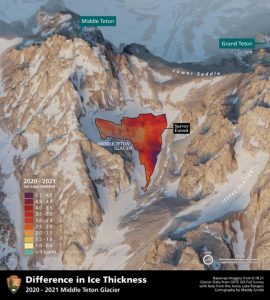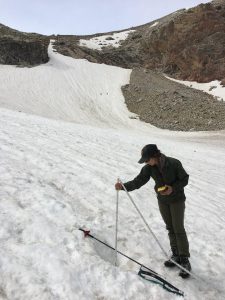What is happening with our Teton Glaciers? 150 years of change”
Presentation: “What is happening with our Teton Glaciers? 150 years of change” by Dr. Simeon Caskey, Grand Teton N.P.
February 6th (Tuesday), 6 p.m., Social half-hour; please join us from 5:30-6:00 to enjoy free soft drinks and appetizers before our talk begins!
Live at the Teton County Library & Via Zoom (online)
The Tetons are a mountain range in northwest Wyoming, USA. Glaciers are responsible for some of the Teton Range’s most iconic features and remain integral to the alpine ecosystem and the recreational visitor experience. Like other alpine glaciers, ice area and volume in the Tetons peaked during the Little Ice Age (LIA). Much work remains to be done to document glacial change in the Teton Range over the course of the last 150 years, from the end of the LIA (maximum glaciation in 1850-1870) to the present day. This presentation will discuss data collection and monitoring efforts and results on glacial extent, volume, and trends. We’ll also discuss drivers of mass-balance for small alpine glaciers, such as Middle Teton Glacier, that account for ~60-80% of all glaciers in mid and low-latitude mountain ranges and are predicted to experience rapid mass loss in the coming decades due to their short response times and narrow elevation ranges, as well as the secondary processes that can decouple these from regional climate forcings.
We’ll share a database of LIA moraines in the Teton Range, an updated remote sensing record of change in glacier area and volume from 1954-2022, in-situ observations of surface elevation change and velocity of Middle Teton Glacier, and a slab model estimating ice thickness and volume across the range. We also consider adding three glaciers to Grand Teton National Park’s 11 commonly recognized glaciers (one near Ice Floe lake and two in the north of the park), and present maps of the Teton’s relic ice and rock glaciers.
All Teton glaciers experienced significant change since the LIA, losing 12-96% (mean=65%) of their visible glaciated area and a cumulative 0.015 km3 of ice loss in the last 50-70 years. Petersen, Ice Floe, and Teepe glaciers fragmented into discontinuous ice patches and only four of Grand Teton National Park’s 14 glaciers retain more than 0.1 km2 of ice. These observations will help inform efforts to understand the future rates of change in ice volume in the Tetons, with implications for alpine ecosystem management and natural hazard mitigation.
Ice Loss, Middle Teton Glacier Ablation Stake, Middle Teton Glacier
Topic: What is happening with our Teton Glaciers? 150 years of change
Time: Tuesday February 6th, 2024 06:00 PM Mountain Time (US and Canada)
Join Zoom Meeting
https://us02web.zoom.us/j/4555651818?pwd=U09ObDNZOEIyZmRtMEtsdUowQnJqdz09
Meeting ID: 455 565 1818
Passcode: 576063


